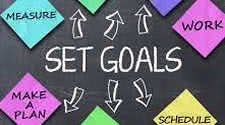Goals Specific Weight Training: Focus on Goals & Results with Specialization

Reaching your Weight Training Goals with Results
Many people participate in training more or less as dabblers. By this I don't mean that they never train hard or that they don't go to the
gym regularly. They may do both. What they don't do, however, is have a definite, planned program that they follow, a program that aims at
a very specific objective. Without an objective it's nearly impossible to achieve the results that a focused schedule gives you.
From the standpoint of basic health and fitness, it's perhaps sufficient to dabble regularly. To achieve real results, however, you must have
a progressive program. Your goal is, to a certain extent, unique. You're the one who has to decide what exactly you want and icon out the
details of how to get it. Nonetheless, there are some general types of goals most trainees share.
All-around Optimum Development
The goal here is to improve your strength, muscular size and shape, fitness and general well-being. If you adhere to a properly arranged routine, virtually everything will improve significantly as you get under way.Specialization
From time to time trainees can boost development in a specific area that all-around work won't hit hard enough. Both lifters and bodybuilders use this type of program sometimes. The most sensible and productive form of specialization emphasizes back or leg work. While arm or shoulder specialization, for instance, is quite popular, it won't produce the same dramatic gains. When weightlifters specialize, they concentrate on a specific lift or some attribute on which they need to improve performance, say, on pulling movements.Performance-Assistance Training
Here the goal is to improve your power or conditioning for a specific sport or activity. Essentially, you're using weight training to improve your skills in scuba diving, baseball, judo, boxing, football, hockey, mountain climbing or whatever. Normally, a good all- around program will provide everything you need. Sometimes, however, people lack the time (or think they do), the energy or the interest to follow an all-around program.They want an abbreviated but effective routine that will help them accomplish their goal. I'll mention here that over the years I've put athletes on supremely effective supplementary routines that E took no more than 20 minutes three times a week.
Contest Preparation
Before competing in a bodybuilding or lifting contest, you follow an intensified program designed to prepare you for the event. Above all, you must have great self-knowledge and sufficient experience in order to determine what exactly you need to do best. Often a knowledgeable coach or trainer can help. Many who train seriously their entire lives never enter contests of any kind, so this goal may not ever interest you.Changing Routines
Even if your specific goal remains constant, you must change the routines you use to achieve it. That doesn't mean your schedule becomes haphazard or changes every few days, as it does so often for dabblers. It means you should follow a routine only as long as it's productive, six to eight weeks for most people, and then make some changes to avoid staleness or overtraining. Whatever your routine, you must progressively increase the demands it makes of your body.This progression will reach a peak after five to eight weeks, and then you need a new progression for another period, gains come from increasing demands. It's Often a good idea to take three to six days completely before starting a new schedule. It's not always necessary, but consider it when you feel really spent after peaking. Then go back to the gym and start your new routine with lightweights. This lets your body recover from the prior buildup, and it renews your enthusiasm.
Let me conclude with some suggestions about how you can continue to train, gain and progress in an efficient and rewarding manner, regardless of your personal goals.
1. When you're following a specialization program, limit yourself to a maximum of two cycles; that is, two successive periods of five to eight weeks. Then switch to some other routine for five to eight weeks, Go back to specializing only after recovering from those two intense periods.
2. Once you've achieved your optimum development, usually after two to three years of steady training, continue to follow definite routines and progressive cycles. These help maintain your enthusiasm and keep you focused on a goal, even if the goal is maintenance.
3. Always use basic, proven movements. Do not force out endless sets of 'little' exercises. Avoid elaborate routines. Keep your training simple and basic.
4. Be sensitive to what fits you best, not only physically but psychologically.
5. Avoid overwork. If any single session exceeds two hours, it's too long. Sixty to 90 minutes is normally quite sufficient.
6. Use proper form. Cheat only rarely—no more than 5 to 10 percent of the time.
7. Be realistic. Appreciate the progress you actually make instead world-class strength athletes. Very few people shouldn't let it bother you if you're not one of them. Focus on improving you.
8. Do not do more than 30 total sets in a single workout.
9. Write out your goals. Keep a notebook, at least for the first few years of training.